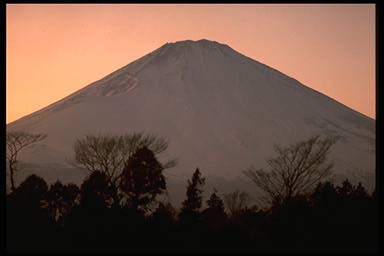JAPANESE BUDDHISM: A HISTORICAL OVERVIEW
Mountain Buddhism
Another alternative to orthodox Nara Buddhism was
MOUNTAIN BUDDHISM, which emphasized kinship with
nature and the kami over the study of Buddhist scriptures,
and ascetic practice to obtain Buddhahood--and adeptness at
magic--over rites to benefit the court. During the Nara
period the mountains lured both ordained monks on retreat
and unlicensed religious practitioners trying to escape the
state's prohibition against unauthorized Buddhist activity. In
the early Heian age, in fact, Buddhism's center of gravity
shifted from the city to the mountains. The Tendai and
Shingon schools, two new versions of Buddhism introduced
from China, both established their most important
monasteries in the mountains, and mountain temples soon
became quite common. Ideally, if rarely in reality, mountain
Buddhism was free of the worldly attachments that
hampered its urban counterpart.

|
Mt. Fuji.
|
Go back to previous section.
 Go on
to next section.
Go on
to next section.
Return to menu page.


 Go on
to next section.
Go on
to next section.